story and photos by Kayte Deioma
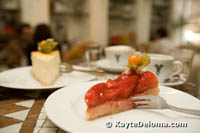 Like afternoon tea in England, Kaffee und Kuchen or coffee and cake is a time-honored ritual in Germany. Rather than serving dessert after a meal as we do in the U.S., sweets get their own dedicated meal mid-afternoon. Restaurants may hold strictly to their Coffee Table hours of 2:30 or 3 pm until 5, then re-open for dinner at 6:30 or 7 pm, but cafes are more flexible, and will serve you coffee and cake until they run out of cake.
Like afternoon tea in England, Kaffee und Kuchen or coffee and cake is a time-honored ritual in Germany. Rather than serving dessert after a meal as we do in the U.S., sweets get their own dedicated meal mid-afternoon. Restaurants may hold strictly to their Coffee Table hours of 2:30 or 3 pm until 5, then re-open for dinner at 6:30 or 7 pm, but cafes are more flexible, and will serve you coffee and cake until they run out of cake.
When it comes to coffee, German varieties tend to be on the mild side. Kaffee Hag is the only brand of decaffeinated coffee widely available in Germany, but most cafes carry only caffeinated coffee. They may have herbal teas or hot chocolate as a decaffeinated alternative. Some cafes also serve alcohol.
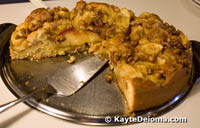 As for cake, the Germans go all out with elegant layer cakes, streusel cakes with different kinds of fruit such as cherry or plum, apple cakes similar to a deep dish pie, fancy fruit tortes and gooey cream cakes. Then there are the cheese cakes, flat or tall, made with different kinds of cheese depending on the baker’s preferences, and sometimes combined with other ingredients like fruit or chocolate.
As for cake, the Germans go all out with elegant layer cakes, streusel cakes with different kinds of fruit such as cherry or plum, apple cakes similar to a deep dish pie, fancy fruit tortes and gooey cream cakes. Then there are the cheese cakes, flat or tall, made with different kinds of cheese depending on the baker’s preferences, and sometimes combined with other ingredients like fruit or chocolate.
Here are some favorite places in Dusseldorf to stop for your Kaffee und Kuchen, depending on where you find yourself on a rainy afternoon.
Café Heinemann
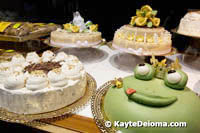 Café Heinemann ( www.cafe-heinemann.de ) is a “destination café.” If you’re only going to stop at one cafe in Dusseldorf, this combination bakery, chocolate shop, cafe and restaurant has something for every sweet tooth and regular food besides. People come from far and wide to buy their chocolates and try their cakes. If you’re going to be shopping on the famed Königsallee, a high end shopping street with a tree-lined moat down the center, that’s a good time to stop at one of the three locations there. There are two at the north end of the boulevard; one at Königsallee 1 and across the street in the Vereinsbank Passage which goes through from Königsallee to Blumenstrasse.
Café Heinemann ( www.cafe-heinemann.de ) is a “destination café.” If you’re only going to stop at one cafe in Dusseldorf, this combination bakery, chocolate shop, cafe and restaurant has something for every sweet tooth and regular food besides. People come from far and wide to buy their chocolates and try their cakes. If you’re going to be shopping on the famed Königsallee, a high end shopping street with a tree-lined moat down the center, that’s a good time to stop at one of the three locations there. There are two at the north end of the boulevard; one at Königsallee 1 and across the street in the Vereinsbank Passage which goes through from Königsallee to Blumenstrasse.
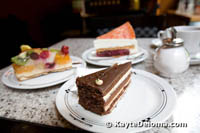 At the south end of Königsallee, signs will direct you around the corner to Bahnstrasse 16. If the tantalizing cake selection in the window doesn’t draw you in, the fanciful chocolates will. In May, the selection included chocolate May beetles filled with champagne truffle and white chocolate asparagus spears in honor of asparagus season. Although the café/bakery is in the Viennese tradition, cakes range from the traditional Mozart torte with layers of chocolate, hazelnut cream and marzipan to the original Hawaii cake with at least seven kinds of fruit. For ease of ordering from the dozen or so varieties available, you select your cake from the display case up front before you sit down and order coffee.
At the south end of Königsallee, signs will direct you around the corner to Bahnstrasse 16. If the tantalizing cake selection in the window doesn’t draw you in, the fanciful chocolates will. In May, the selection included chocolate May beetles filled with champagne truffle and white chocolate asparagus spears in honor of asparagus season. Although the café/bakery is in the Viennese tradition, cakes range from the traditional Mozart torte with layers of chocolate, hazelnut cream and marzipan to the original Hawaii cake with at least seven kinds of fruit. For ease of ordering from the dozen or so varieties available, you select your cake from the display case up front before you sit down and order coffee.
Rondo Café and Bar
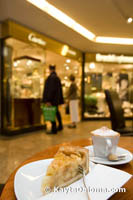 If you’re inside the maze of shopping passages along the east side of Königsallee, make your way to the top of the rotunda in the Kö Galerie to the Rondo Café & Bar. The tables all have a view down into the many levels of exclusive shops below, and if you can’t afford the Cartier shop next to the café, coffee and cake is no more expensive than anywhere else in town. The cakes are made by the same baker who supplies the café at the Benrath Palace. You won’t find the 25 varieties available at Benrath, but the half a dozen on offer each day are sure to be excellent. I recommend the Apfelkuchen (apple cake). Rondo Café, Königsallee 60 in the Kö Galerie.
If you’re inside the maze of shopping passages along the east side of Königsallee, make your way to the top of the rotunda in the Kö Galerie to the Rondo Café & Bar. The tables all have a view down into the many levels of exclusive shops below, and if you can’t afford the Cartier shop next to the café, coffee and cake is no more expensive than anywhere else in town. The cakes are made by the same baker who supplies the café at the Benrath Palace. You won’t find the 25 varieties available at Benrath, but the half a dozen on offer each day are sure to be excellent. I recommend the Apfelkuchen (apple cake). Rondo Café, Königsallee 60 in the Kö Galerie.
Café Schwan
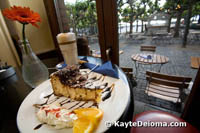 If you’re in the Altstadt ( Old Town), a nice place for an afternoon break isCafé Schwan, right on the square across from the old Schlossturm ( Castle Tower). If the weather is nice, there’s plenty of outdoor seating, but there’s lots of room inside too. The cake selection may not be very large, but you can pretty much depend on finding a great piece of cheesecake. Proprietor Kerstin Schwan, who also owns several other Dusseldorf restaurants, offers a full menu of German and international cuisine at the cafe. It’s especially popular for breakfast or brunch. Mühlenstraße 2 on the Burgplatz
If you’re in the Altstadt ( Old Town), a nice place for an afternoon break isCafé Schwan, right on the square across from the old Schlossturm ( Castle Tower). If the weather is nice, there’s plenty of outdoor seating, but there’s lots of room inside too. The cake selection may not be very large, but you can pretty much depend on finding a great piece of cheesecake. Proprietor Kerstin Schwan, who also owns several other Dusseldorf restaurants, offers a full menu of German and international cuisine at the cafe. It’s especially popular for breakfast or brunch. Mühlenstraße 2 on the Burgplatz
Café Curtiz im KIT
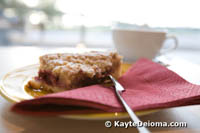 If your exploring Kunst im Tunnel (Art in the Tunnel), plan your visit to coincide with a coffee break at the Café Curtiz im KIT. It’s also a full restaurant with a nice view of the Rhine River and the Rheinkniebrueke (literally, Rhine knee bridge, for the bend in the river where it crosses). The Café can also provide an inexpensive dinner if you’re planning a visit to the Apollo Theater next door and didn’t buy the dinner tickets there.
If your exploring Kunst im Tunnel (Art in the Tunnel), plan your visit to coincide with a coffee break at the Café Curtiz im KIT. It’s also a full restaurant with a nice view of the Rhine River and the Rheinkniebrueke (literally, Rhine knee bridge, for the bend in the river where it crosses). The Café can also provide an inexpensive dinner if you’re planning a visit to the Apollo Theater next door and didn’t buy the dinner tickets there.
Bazzar Caffé
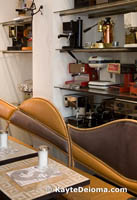
If you care more about the coffee than the cake, Bazzar Caffé(www.bazzar.de) at Heinrich-Heine-Allee 53 in the Wilhelm Marx building is an homage to the dark brew. Floor to ceiling shelves display just about every kind of coffee making gadget ever invented. They have coffee specialties with and without alcohol – or alcohol with and without coffee if you prefer. They also serve sandwiches, salads and a full breakfast menu. Cake selections vary.
Top 180 at the Rheinturm
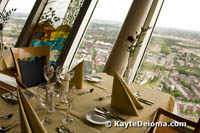 The rotating Top 180 (www.rheinturm-restaurants-duesseldorf.de) restaurant atop the Rheinturm ( Rhine Tower) serves Kaffee und Kuchen from 2:30 to 5 pm. You have to pay the entrance fee to the tower to go up to the restaurant, but if you’re going up anyway, you might as well stop for cake, right? Alas, I missed the official cake hours and was too early for dinner, so I could just look longingly at the leftovers and enjoy the view.
The rotating Top 180 (www.rheinturm-restaurants-duesseldorf.de) restaurant atop the Rheinturm ( Rhine Tower) serves Kaffee und Kuchen from 2:30 to 5 pm. You have to pay the entrance fee to the tower to go up to the restaurant, but if you’re going up anyway, you might as well stop for cake, right? Alas, I missed the official cake hours and was too early for dinner, so I could just look longingly at the leftovers and enjoy the view.
Neanderthal Café
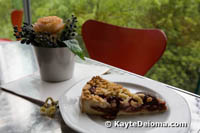 If you make the trip out to the Neanderthal Museum near Mettman, you’ll be surrounded by café/restaurants if you want to get out of the museum for a break. But you don’t have to leave the building to find a delicious piece of cake. Several varieties are served daily along with a tranquil view of the woods from the upstairs Café inside the museum.
If you make the trip out to the Neanderthal Museum near Mettman, you’ll be surrounded by café/restaurants if you want to get out of the museum for a break. But you don’t have to leave the building to find a delicious piece of cake. Several varieties are served daily along with a tranquil view of the woods from the upstairs Café inside the museum.

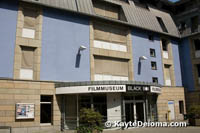 From early cave paintings, man has been fascinated with reproducing the physical world in two dimensions, and finding ways to represent the concepts of motion and the passage of time. The Film Museum in Dusseldorf takes you along on the fascinating journey of technological development from those earliest depictions of motion through the many precursors to photographic moving pictures up to the advent of moving film frames. The ground floor of the Film Museum is the Black Box Theater which shows historic and current art films. The museum exhibits begin up one level on the first floor. Although all the history is there, it’s not really laid out chronologically. Historical elements are introduced throughout.
From early cave paintings, man has been fascinated with reproducing the physical world in two dimensions, and finding ways to represent the concepts of motion and the passage of time. The Film Museum in Dusseldorf takes you along on the fascinating journey of technological development from those earliest depictions of motion through the many precursors to photographic moving pictures up to the advent of moving film frames. The ground floor of the Film Museum is the Black Box Theater which shows historic and current art films. The museum exhibits begin up one level on the first floor. Although all the history is there, it’s not really laid out chronologically. Historical elements are introduced throughout.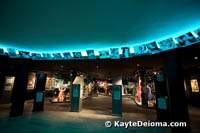 You enter through the Pantheon of Film History, a tribute to directors honoring the contributions of early Russian, Polish, Japanese, Italian, and of course, German filmmakers like Rainer Werner Fassbinder, Werner Herzog and Dusseldorf native son, Wim Wenders. Hollywood icons like Alfred Hitchcock and Charlie Chaplin are included as well. Photos circle a domed ceiling and interactive video columns allow you to watch short film excerpts.
You enter through the Pantheon of Film History, a tribute to directors honoring the contributions of early Russian, Polish, Japanese, Italian, and of course, German filmmakers like Rainer Werner Fassbinder, Werner Herzog and Dusseldorf native son, Wim Wenders. Hollywood icons like Alfred Hitchcock and Charlie Chaplin are included as well. Photos circle a domed ceiling and interactive video columns allow you to watch short film excerpts.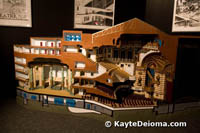 Beyond the Pantheon, the “Movie Cult – Movie Theater” room is devoted to the movie house experience. Movie posters featuring Marlene Dietrich, Greta Garbo and Ingred Bergman line the walls. There is a model of the 6200-seat Roxy Theatre in New York, the largest silent movie theater built in its day. A traveling cinema from around 1910 has been recreated and is used occasionally to show films for group tours.
Beyond the Pantheon, the “Movie Cult – Movie Theater” room is devoted to the movie house experience. Movie posters featuring Marlene Dietrich, Greta Garbo and Ingred Bergman line the walls. There is a model of the 6200-seat Roxy Theatre in New York, the largest silent movie theater built in its day. A traveling cinema from around 1910 has been recreated and is used occasionally to show films for group tours.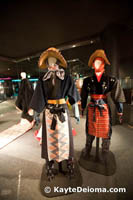 In the center of this area, period movie costumes from various international films, including Akira Kurasawa’s Dreams, are displayed in glass cases. There is also an exhibit of movie-related merchandise, from Charlie Chaplin and Laurel and Hardy memorabilia to Star Wars action figures and Disney character toys.
In the center of this area, period movie costumes from various international films, including Akira Kurasawa’s Dreams, are displayed in glass cases. There is also an exhibit of movie-related merchandise, from Charlie Chaplin and Laurel and Hardy memorabilia to Star Wars action figures and Disney character toys.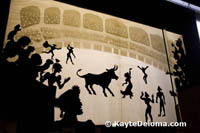 On the second floor, a collection of original shadow puppets from Turkey, China and Indonesia show how these early cut-outs were used to create the experience of watching a story take place on a screen. German filmmaker Lotte Reiniger combined silhouettes like these with film to create animated films in the 1920s and 30s. Silhouettes used in her films The Adventure of Prince Achmed, Harlekin, Carmen, and the unfinished work, Prosperina, are on display.
On the second floor, a collection of original shadow puppets from Turkey, China and Indonesia show how these early cut-outs were used to create the experience of watching a story take place on a screen. German filmmaker Lotte Reiniger combined silhouettes like these with film to create animated films in the 1920s and 30s. Silhouettes used in her films The Adventure of Prince Achmed, Harlekin, Carmen, and the unfinished work, Prosperina, are on display.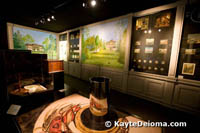 In the ” Palace of Illusions,” the press of a button changes the room lighting to show off the special effects created in 17th century “light paintings.” Back lighting allows different parts of the painting to glow, so that as day turns to night in the picture, the moon shines and lanterns and windows become lit.
In the ” Palace of Illusions,” the press of a button changes the room lighting to show off the special effects created in 17th century “light paintings.” Back lighting allows different parts of the painting to glow, so that as day turns to night in the picture, the moon shines and lanterns and windows become lit.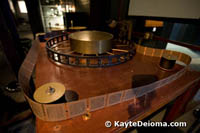 The second floor is also home to a display of the progression in development of film cameras and projecting equipment in “The Captured Outer World” and “The Projected Inner World”. The collection includes German, American, Russian and French cameras from the turn of the century through the 1980s. There is a functional replica of Le Théatre Optique, a precursor to film which projected a series of hand-painted frames on a transparent screen to simulate movement. It is sometimes demonstrated on group tours.
The second floor is also home to a display of the progression in development of film cameras and projecting equipment in “The Captured Outer World” and “The Projected Inner World”. The collection includes German, American, Russian and French cameras from the turn of the century through the 1980s. There is a functional replica of Le Théatre Optique, a precursor to film which projected a series of hand-painted frames on a transparent screen to simulate movement. It is sometimes demonstrated on group tours.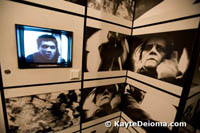 Another series exhibits demonstrates how camera angle and editing can replicate or reinvent reality. Video clips from Polish filmmaker Wsewolod Pudowkin’s short film The Mother, and Jonathan Demme’s Silence of the Lamb are shown on small screens surrounded by individual frames from the films to illustrate choices that are made in editing.
Another series exhibits demonstrates how camera angle and editing can replicate or reinvent reality. Video clips from Polish filmmaker Wsewolod Pudowkin’s short film The Mother, and Jonathan Demme’s Silence of the Lamb are shown on small screens surrounded by individual frames from the films to illustrate choices that are made in editing.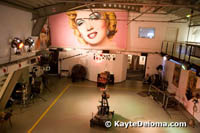 The third level takes you into the world of silent films in one room and sound effects in the next. Then pass through a film studio, where cameras, lights and a wind machine are all set to go, and a painted cardboard cutout of the back of a man in jeans and a leather jacket stands at a bar. Museum patrons used to be able to use the camera on the dolly in the middle of the room, but it has been vandalized and doesn’t work any more.
The third level takes you into the world of silent films in one room and sound effects in the next. Then pass through a film studio, where cameras, lights and a wind machine are all set to go, and a painted cardboard cutout of the back of a man in jeans and a leather jacket stands at a bar. Museum patrons used to be able to use the camera on the dolly in the middle of the room, but it has been vandalized and doesn’t work any more.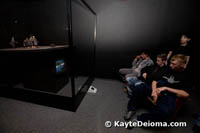 Also on level three you’ll find an introduction to animation, from graphics to “stop action”. The 1988 Academy Award winning short animation, Balance, by German bothers Christoph and Wolfgang Lauenstein, plays on a small screen underneath a platform where the original stop-action figures from the film are mounted.
Also on level three you’ll find an introduction to animation, from graphics to “stop action”. The 1988 Academy Award winning short animation, Balance, by German bothers Christoph and Wolfgang Lauenstein, plays on a small screen underneath a platform where the original stop-action figures from the film are mounted.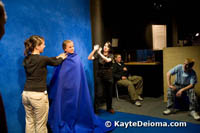 The Blue Screen exhibit lets you try out some special effects for yourself, standing in front of the blue screen and seeing yourself on television against a different background. A blue wrap lets you become a floating head or headless body, or whatever else you can dream up.
The Blue Screen exhibit lets you try out some special effects for yourself, standing in front of the blue screen and seeing yourself on television against a different background. A blue wrap lets you become a floating head or headless body, or whatever else you can dream up.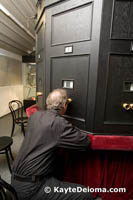 On the fourth and final floor, a Kaiserpanorama takes center stage. Invented in 1880, this ten-sided black tower surrounded by chairs has stereo viewers at each position where visitors can sit and look at black and white travel photos in 3D. Every few second, the photos inside the box rotate so you get a new view. Kaiserpanoramas were popular in Germany until the 1930s. Other technologies for three dimensional viewing from painted glassine panel sets to View Master slide-wheel viewers to holographic projections complete the exhibit.
On the fourth and final floor, a Kaiserpanorama takes center stage. Invented in 1880, this ten-sided black tower surrounded by chairs has stereo viewers at each position where visitors can sit and look at black and white travel photos in 3D. Every few second, the photos inside the box rotate so you get a new view. Kaiserpanoramas were popular in Germany until the 1930s. Other technologies for three dimensional viewing from painted glassine panel sets to View Master slide-wheel viewers to holographic projections complete the exhibit.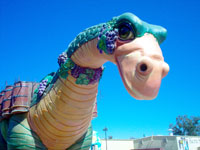 Everything at Mardi Gras World is larger than life. You feel a bit like Alice in Wonderland after eating the cake that makes you smaller and smaller. To enhance the fantasy, you may adorn yourself in Mardi Gras finery to explore the giant floats created over the years by Blaine Kern and a staff of talented artists. Since the 1950’s Blaine Kern has been redefining the Mardi Gras experience with bigger and grander floats designed to last more that one Mardi Gras season. In addition to Mardi Gras, Blaine Kern Studios provide floats, statues and props for theme parks, parades, movie sets and events around the world.
Everything at Mardi Gras World is larger than life. You feel a bit like Alice in Wonderland after eating the cake that makes you smaller and smaller. To enhance the fantasy, you may adorn yourself in Mardi Gras finery to explore the giant floats created over the years by Blaine Kern and a staff of talented artists. Since the 1950’s Blaine Kern has been redefining the Mardi Gras experience with bigger and grander floats designed to last more that one Mardi Gras season. In addition to Mardi Gras, Blaine Kern Studios provide floats, statues and props for theme parks, parades, movie sets and events around the world.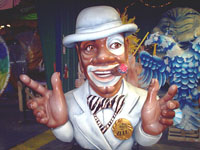 The tour is introduced by a guide and includes a brief film about the history of Mardi Gras and of Blaine Kern studios. You can choose your Mardi Gras regalia – will it be pink feathers and a glittery crown or an armored cloak? Then explore on your own the warehouses full of fiberglass floats including the massive animatronic dragon, Leviathan, that was the largest float in Carnival history when it was created in 1998, or the even larger 5-tandem superfloat, the SS Captain Eddie which took over the record for longest float in the 1999 season.
The tour is introduced by a guide and includes a brief film about the history of Mardi Gras and of Blaine Kern studios. You can choose your Mardi Gras regalia – will it be pink feathers and a glittery crown or an armored cloak? Then explore on your own the warehouses full of fiberglass floats including the massive animatronic dragon, Leviathan, that was the largest float in Carnival history when it was created in 1998, or the even larger 5-tandem superfloat, the SS Captain Eddie which took over the record for longest float in the 1999 season.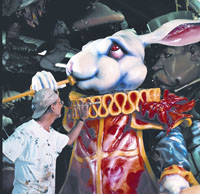 You will also have the opportunity to visit the studios where designers, painters and sculptors are hard at work repairing and creating characters of all sizes for various purposes. Yellow arrows lead you to the float-building warehouses where carpenters and painters are hard at work constructing floats.
You will also have the opportunity to visit the studios where designers, painters and sculptors are hard at work repairing and creating characters of all sizes for various purposes. Yellow arrows lead you to the float-building warehouses where carpenters and painters are hard at work constructing floats.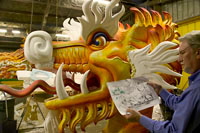 Located directly across from the French Quarter, Algiers can be reached by driving across the New Orleans Bridge or taking the free ferry from Canal Street. On a rainy day, you might want to drive if you have wheels. The bridge takes you close to Mardi Gras World, but you can also take your car on the ferry for $1. The ferry runs from 6 am to 8:45 pm daily, departing every 15 or 20 minutes, depending on how long it takes to load and unload on each side of the river. The crossing itself only takes about 5 minutes. A shuttle from Mardi Gras World picks up visitors every 15 minutes at the Algiers ferry station. On the return trip, the shuttle makes an optional stop at HooDoo Town.
Located directly across from the French Quarter, Algiers can be reached by driving across the New Orleans Bridge or taking the free ferry from Canal Street. On a rainy day, you might want to drive if you have wheels. The bridge takes you close to Mardi Gras World, but you can also take your car on the ferry for $1. The ferry runs from 6 am to 8:45 pm daily, departing every 15 or 20 minutes, depending on how long it takes to load and unload on each side of the river. The crossing itself only takes about 5 minutes. A shuttle from Mardi Gras World picks up visitors every 15 minutes at the Algiers ferry station. On the return trip, the shuttle makes an optional stop at HooDoo Town.